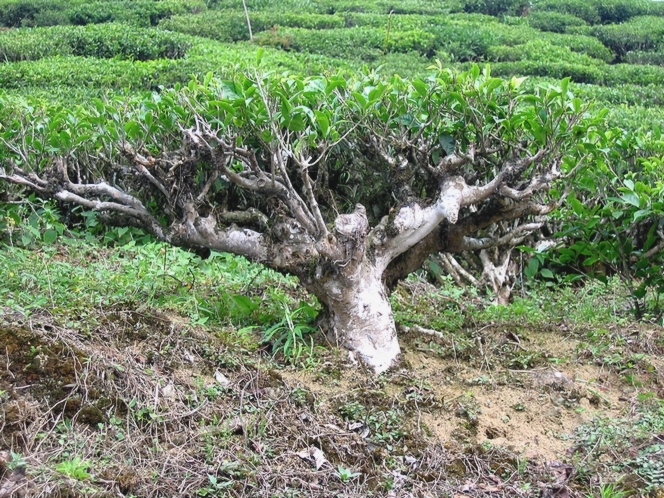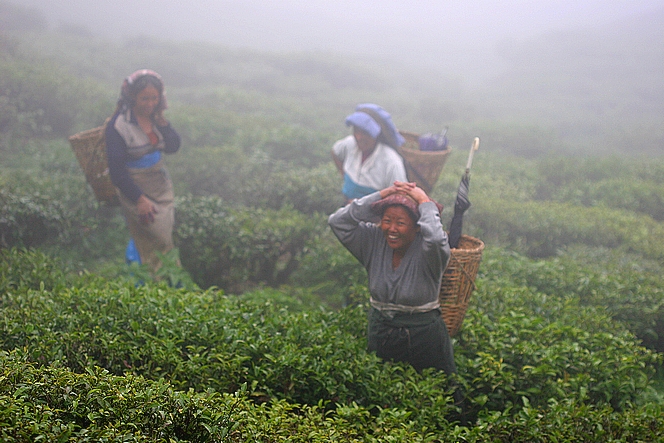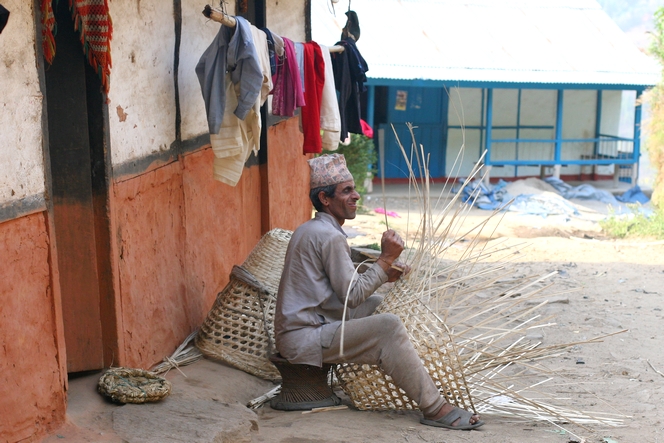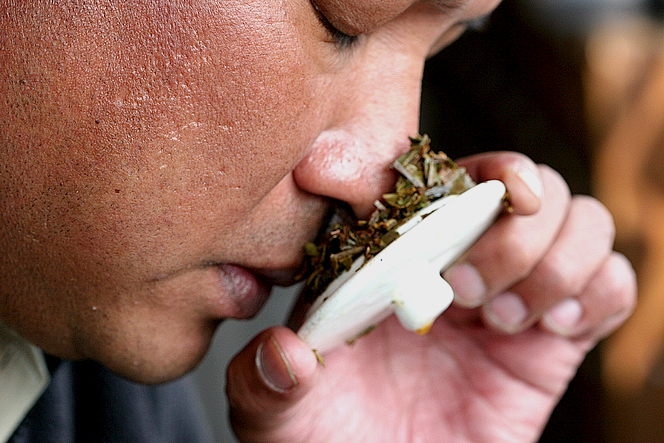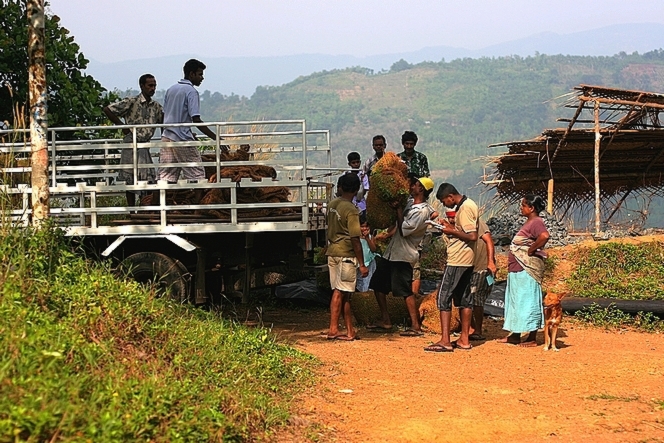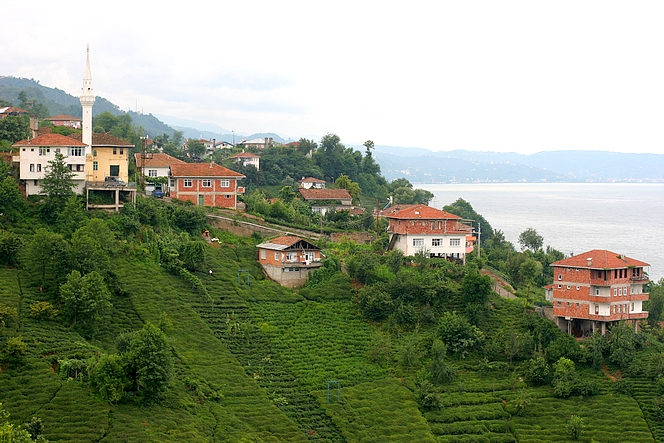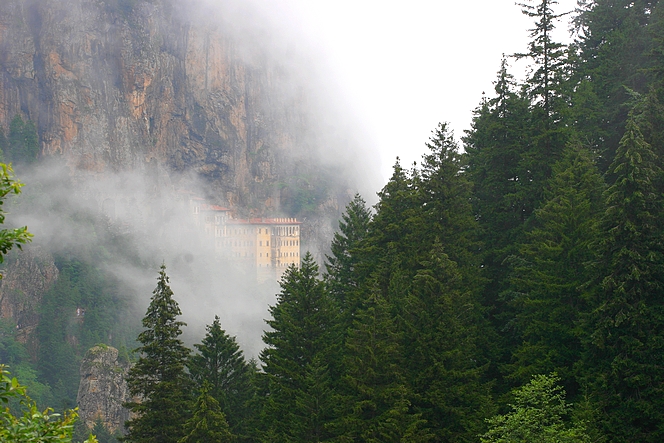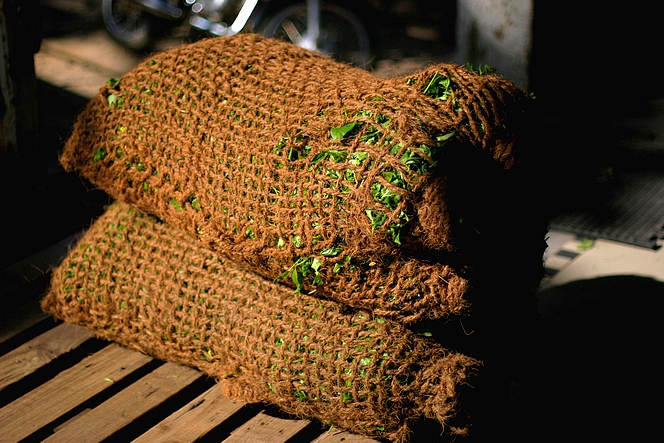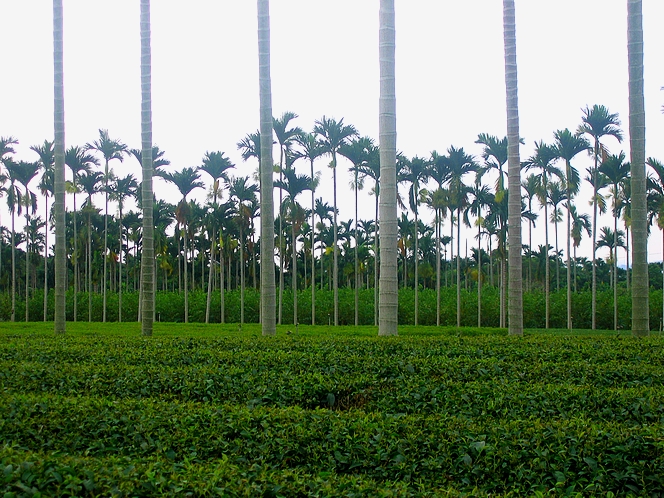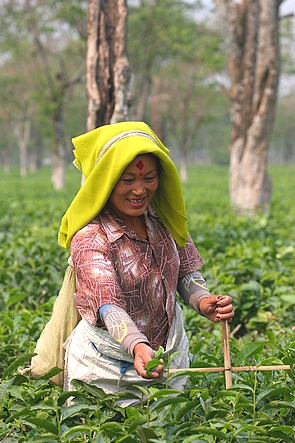I mustn’t deceive you about the character of the tea plant. Don’t think that just because this shrub is kept close to the ground through successive pruning and harvesting that it is weedy or fragile in any way. The tea plant is nothing of the sort – on the contrary. Because it is constantly frustrated in its growth, the trunk of each shrub becomes incredibly thick. It is wide, knotted, twisted; in fact, a tea plantation looks rather like a forest of bonsais.
ARCHIVE FOR 2010
Tea pluckers in the mist of Badamtam
In the middle of summer, a bit of freshness is always welcome. Like this refreshing mist coming from the foothills of the Himalayas. People there are so used to living in the clouds that this humidity is part of their life and no-one pays any attention to it. It’s actually not unpleasant, just look at the faces of these tea pluckers and you’ll see that no-one seems depressed by it. They look like they’re having fun, in fact.
This is at Badamtam, a magnificent plantation located in the north of Darjeeling, across from Sikkim.
Just a detail: do you see the umbrella in the basket? Well, it is actually used when the sun comes out, to provide shade and keep a nice complexion.
Basket made for harvesting tea
Plucking tea, practically leaf by leaf, is a major undertaking. In some countries, pickers carry baskets on their backs to hold the leaves. These baskets have an open weave to allow the air to circulate inside and prevent the leaves from fermenting, which would spoil the pickers’ hard work.
There are several clues to the fact that I took this photo in Nepal: the man’s attire, particularly his hat, which is the kind worn by many Nepalese; the house with its ochre finish halfway up the mud walls, and the white sections picked out by the darker lines; lastly, for those who’ve spent time on the tea plantations, the shape of the basket itself, which becomes square as it widens at the top, and exists only in this region.
This scene took place near Phidim, in the far north of Ilam Valley, in the easternmost part of Nepal (Kanchenjunga Tea Estate is nearby; the Nepal Green Tea Factory and the Himalayan Shangri-La Tea Factory are a little further away).
Nepal remains a largely rural country. Here, two hours’ walk from the nearest village, people obviously need to do everything for themselves. They weave in front of their homes, without becoming distracted by the stranger taking photos of them.
To choose tea, you need to have a good nose
When you taste tea, you first start by smelling it. This is a very important stage in the tasting process. You look at the infused leaves, inhale them and by doing so you already get lots of information on the tea. You could for example easily detect problems such as an over-drying, an overly long oxidization process if it’s black tea, or inappropriate fermentation. But of course it also allows you to identify the qualities of the tea and the different scents you could find again in the cup in more or less similar ways.
It’s only after smelling the infused leaves (what is called “infusion” in the trade) that we actually taste the liquor itself.
Here, in Badamtam (Darjeeling), Binod Gurung has his eyes closed. His nose is plunged in the damp, warm leaves. He inhales, analyses, all in a state of complete concentration.
Tea leaves that are worth a detour
In the south of Sri Lanka, tea is mostly grown by individual farmers who cultivate their own land. They sell the tea leaves just after the harvest, as they don’t have the infrastructure to process them. The farmers don’t have to go far to find buyers: their freshly plucked tea leaves are very much wanted by the local tea factories, who even go and collect the bags filled with fresh tea leaves themselves because of competition.
I spent hours going round the farms in one of these 4x4s fitted out with trays and it’s an incredible experience: we sometimes had to get the bags high in the mountains, skidding on the steep slopes, driving along vertiginous drops, crossing forests under cries of monkeys. We’d then suddenly end up on the top of a mountain in the middle of nowhere, around farmers breeding cattle and living out of different cultivations.
So we’d buy the tea leaves, chat a little, maybe drink a tea together. We’d talk. We’d laugh. And it’d then be time to go and collect more tea bags from other isolated farms.
The Sumela monastery
In case you had of Turkey an image of a very hot country, I’d like to tone it down a bit. If tea enjoys being on these mountains lining the Black Sea, it’s exactly because here when you climb up a little, it’s much cooler and there are plenty of clouds and rain. “It rains all the time in Rize and if it doesn’t rain it snows !” have I often heard.
The Sumela monastery –whose picture can only be taken by patient people- is precisely located in the area where tea is grown. You can notice that nature looks close to the one found in the Alps. And these threads of fog remind me of the Himalayan foothills. So now you surely understand why tea enjoys it here !
The Sumela monastery
In case you had of Turkey an image of a very hot country, I’d like to tone it down a bit. If tea enjoys being on these mountains lining the Black Sea, it’s exactly because here when you climb up a little, it’s much cooler and there are plenty of clouds and rain. “It rains all the time in Rize and if it doesn’t rain it snows !” have I often heard.
The Sumela monastery –whose picture can only be taken by patient people- is precisely located in the area where tea is grown. You can notice that nature looks close to the one found in the Alps. And these threads of fog remind me of the Himalayan foothills. So now you surely understand why tea enjoys it here !
Tea is in the bag
What a beautiful warm evening light illuminating these string bags filled with fresh tea leaves. This is happening in Dellawa (Sri Lanka). In a few minutes, these leaves will be taken to the top floor of the tea factory where they’ll undergo the first stage of processing: withering. A stage that can take up to 20 hours for this type of black tea and consists simply in remaining the leaves spread out in thin, long and well ventilated trays. Water will thereby be taken out of the fresh tea leaves.
Under the palm trees of Nantou, Dong Ding tea
In Taiwan, in the Nantou region for example, well-known for its Wu Long teas (Dong Ding, etc.), the tall and spindly trunks of the palm trees contrast with the rows of tea plants and give the landscape a very graphic appearance.
I have to admit that this impression is emphasized by the fact that I have been a little disrespectful to the posers in the foreground by chopping their head off…
Cheerful plucker looking like a tea missionary
On the Terai plain (area straddling Nepal and India), I’ve seen them use strange crosses to mark the height of tea plants. The cross is stuck into the ground and only the shoots growing above the horizontal bar are plucked. It makes this cheerful plucker look a bit like a tea missionary.

